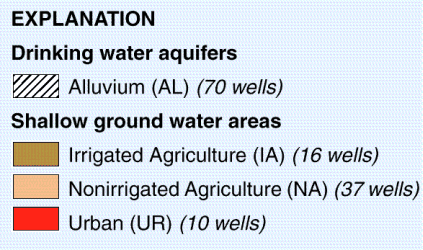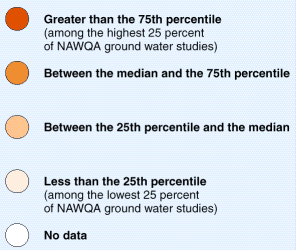|
Seven major water quality characteristics were evaluated for stream sites in each NAWQA Study Unit. Summary scores for each characteristic were computed for all sites that had adequate data. Scores for each site in the Willamette Basin were compared with scores for all sites sampled in the 20 NAWQA Study Units during 1992-95. Results are summarized by percentiles; higher percentile values generally indicate poorer quality compared with other NAWQA sites. Water quality conditions at each site also are compared to established criteria for protection of aquatic life. Applicable criteria are limited to nutrients and pesticides in water, semivolatile organic compounds in bed sediment, and organochlorine pesticides and PCBs in bed sediment. (Methods used to compute rankings and evaluate aquatic life criteria are described by Gilliom and others, in press.) |
|
EXPLANATION Ranking of stream quality relative to all NAWQA stream sites --Darker colored circles generally indicate poorer quality. Bold outline of circle indicates one or more aquatic life criteria were exceeded.
|
|
Five major water quality characteristics were evaluated for ground water studies in each NAWQA Study Unit. Ground water resources were divided into two categories: (1) drinking water aquifers, and (2) shallow ground water underlying agricultural or urban areas. Summary scores were computed for each characteristic for all aquifers and shallow ground water areas that had adequate data. Scores for each aquifer and shallow ground water area in the Willamette Basin were compared with scores for all aquifers and shallow ground water areas sampled in the 20 NAWQA Study Units during 1992-95. Results are summarized by percentiles; higher percentile values generally indicate poorer quality compared with other NAWQA ground water studies. Water quality conditions for each drinking water aquifer also are compared to established drinking water standards and criteria for protection of human health. (Methods used to compute rankings and evaluate standards and criteria are described by Gilliom and others, in press.) |
Ranking of ground water quality relative to all NAWQA ground water studies -- Darker colored circles generally indicate poorer quality. Bold outline of circle indicates one or more drinking water standards or criteria were exceeded.

